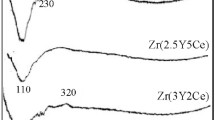Combination light scattering spectroscopy and infrared spectroscopy are used to study ZrO2 powder stabilized with 2, 3, 5, and 7 mol.% Y2O3. Changes in spectra are demonstrated connected with an increase in amount ofstabilizing addition. Differential thermal analysis establishes that variation of Y2O3 content affects the position of peaks for thermal and thermogravimetric effects during oxide calcination.





Similar content being viewed by others
References
Kim Sung-Dai and Hwang Kyu-Seog, “Crystallinity, microstructure and mechanical strength of yttria-stabilized tetragonal zirconia ceramics for optical ferrule,” Mater. Sci. Applications, No. 2, 1 – 5 (2011).
V. V. Lashneva, A. V. Shevchenko, and E. V. Dudnik, “Bioceramic based on zirconium dioxide,” Steklo Keram., No. 4, 25 – 28 (2009).
V. N. Antsiferov, S. E. Porozova, I. V. Solnyshkov, et al., “Effect of zirconium dioxide carrier presence and structure on nickel cat-alyst properties for a methane oxidizing converter,” Perspektivnye Materialy, No. 11, 65 – 70 (2013).
S. N. Orlik, V. L. Struzhko, T. V. Mironyuk, et al., “Bifunctionality role of oxide systems based on ZrO2 in the process of NO reduction by light hydrocarbons,” Kinetika Kataliz, 44(5), 744 – 754 (2003).
V. N. Antsiferov, S. E. Porozova, and V. B. Kul’met’eva, “Effect of water soluble polymer additives on the phase composition and size of zirconia particles during precipitation from salt solutions,” lass Phys. Chem., 38(3), 322 – 326 (2012).
S. E. Porozova, V. B. Kul’met’eva, A. A. Gurov, and D. S. Vokhmyanin, “Thermomechanical analysis as a tool for optimizing sintering regimes for ceramic materials based on zirconium dioxide,” Refract. Indust. Ceram., 54(4), 307 – 311 (2013).
A. K. Deb, P. Chatterjee, and S. P. Sen Gupta, “Synthesis and microstructural characterization of α-Al2O3–t-ZrO2 composite powders prepared by combustion technique,” Mater. Sci. Eng., A459. 124 – 131 (2007).
A. Ghosh, A. K. Suri, M. Pandey, et al., “Nanocrystalline zirconia- yttria system — a Raman study,” Mater. Lett., No. 60, 1170 – 1173 (2006).
Yu. A. Pentin and G. M. Kuramshina, Bases of Molecular Spectroscopy [in Russian], Mir Binom. Lab. Znanii, Moscow (2008).
Author information
Authors and Affiliations
Corresponding author
Additional information
Translated from Novye Ogneupory, No. 7, pp. 6 – 9, July 2015.
Rights and permissions
About this article
Cite this article
Porozova, S.E., Solnyshkov, I.V., Kul’met’eva, V.B. et al. Features of ZrO2–Y2O3 System Nanopowders with a Different Y2O3 Content. Refract Ind Ceram 56, 333–336 (2015). https://doi.org/10.1007/s11148-015-9843-z
Received:
Published:
Issue Date:
DOI: https://doi.org/10.1007/s11148-015-9843-z




